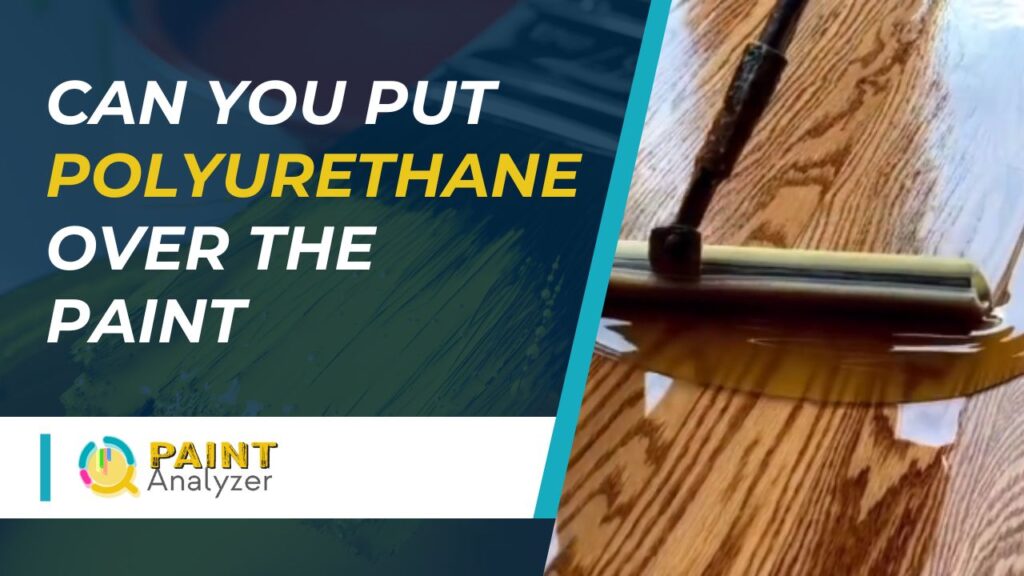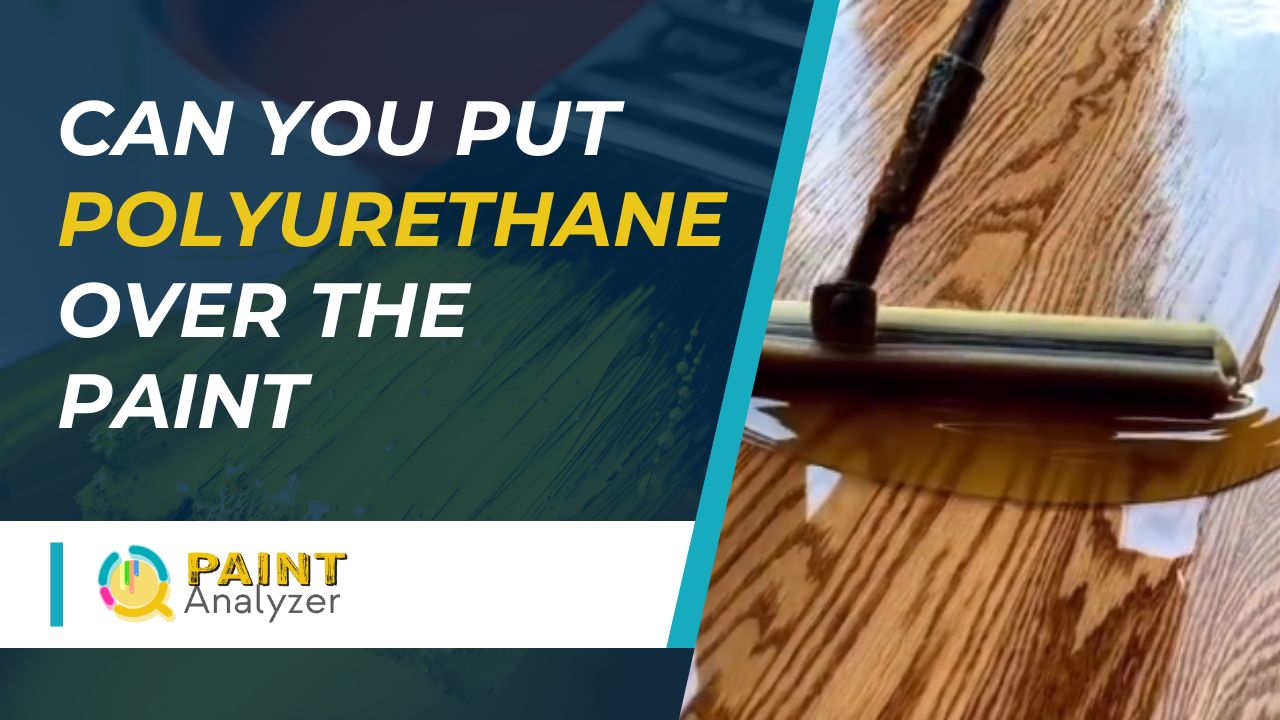Painting is a popular and cost-effective option for transforming and refreshing the appearance of furniture, cabinets, and other wooden surfaces. However, paint alone is insufficient to keep the wooden surface free from scratches, scuffs, and damage caused by constant use. That’s where polyurethane comes in.
Polyurethane is a clear finish that can be applied over latex and oil-based paint. However, it would be best to do a few things before applying polyurethane over the paint, such as allowing the paint to fully cure and sanding the surface to create a smooth finish.
I’ll show you how to apply polyurethane over paint like a pro. We’ll also give you a few tips on how to get the best results. So, let’s get started.

Can polyurethane be applied over a painted surface?
Applying polyurethane over a painted surface is a common finishing technique to enhance the paint job’s durability, protection, and appearance. Polyurethane is a clear, hard-wearing topcoat that can provide an extra layer of protection against wear, moisture, and UV damage.
This versatile finish can be used on various surfaces, including wood, metal, and plastics. Here are some key points to consider when contemplating the application of polyurethane over a painted surface:
Compatibility
It’s crucial to ensure compatibility between the two products before applying polyurethane over paint. Some types of paint may not adhere well to polyurethane, leading to adhesion issues or an uneven finish. Always perform a small test in an inconspicuous area to determine if the polyurethane bonds effectively with the existing paint.
Surface Preparation
Proper surface preparation is essential for a successful outcome. Thoroughly clean the painted surface to remove dust, dirt, and contaminants. Lightly sand the surface to create a slightly rough texture, which helps the polyurethane adhere better. Make sure the paint is fully cured before applying polyurethane.
Types of Polyurethane
Different types of polyurethane finishes are available, including water-based and oil-based options. Water-based polyurethane tends to have a milder odor, dries more quickly, and offers good UV resistance. Oil-based polyurethane provides a more durable and protective finish, particularly for high-traffic areas.
Application
Apply the polyurethane using a high-quality brush, roller, or sprayer, following the manufacturer’s instructions. Apply thin, even coats and allow each coat to dry completely before applying the next. Sand lightly between coats for better adhesion and a smoother finish.
Finish Sheen
Polyurethane is available in various sheens, including gloss, semi-gloss, and satin. Choose a sheen that complements the aesthetic of your project. Remember that a glossier finish may highlight imperfections in the painted surface.
Protection and Maintenance
Polyurethane protects against daily wear and tear, spills, and scratches. It forms a barrier that helps prevent the paint from chipping or peeling. Regular maintenance, such as cleaning with a mild soap and water solution, will help preserve the finish’s appearance over time.
Test and Consultation
If you’re unsure about applying polyurethane over a specific type of paint or surface, consider seeking advice from paint professionals or consulting the manufacturer’s recommendations.
How to Put Polyurethane Over Paint? A step-by-step guide
It is not uncommon for people to put a layer of polyurethane over their painted surfaces. This can be done for several reasons, such as to protect the paint from wear and tear or to create a different look.
Whatever the reason, it is not difficult and can be done in a few simple steps. Here is a step-by-step guide on how to put polyurethane over paint:
Step 1: Prepare the surface
Start by ensuring the surface is clean and free of any dirt or debris. You can do this by wiping it down with a damp cloth. Once the surface is clean, you will need to sand it down.
This is important because it will create a smooth surface for the polyurethane to adhere to. If you skip this step, the polyurethane will not adhere properly and eventually peel off.
Step 2: Apply the polyurethane
Once the surface is prepared, you can start applying the polyurethane. You will need to use a brush or roller for this. Start by applying a thin layer of polyurethane to the surface.
Be sure to work in small sections so the polyurethane does not dry before you can spread it evenly.
Step 3: Let it dry
After you have applied the first layer of polyurethane, you will need to let it dry. This usually takes around 24 hours. Once it is dry, you can sand it down with fine-grit sandpaper. This will help to create an even surface.
Step 4: Apply a second coat
After the first coat has dried, you can apply a second coat of polyurethane. Again, work in small sections and let it dry completely before moving on.
Step 5: Let it cure
Once the final coat of polyurethane has dried, you must let it cure. This usually takes around 24 hours. Once it has cured, you can enjoy your newly protected surface!
Is it possible to Apply Polyurethane over Latex Paint?
Applying polyurethane over latex paint is possible, but there are a few things to remember. First, ensure the paint is completely dry before applying the polyurethane. If the paint is still wet, it can cause the polyurethane to bubble and peel.
Using water-based polyurethane over latex paint is best because oil-based polyurethanes can yellow and discolor the paint over time.
When applying polyurethane, use a brush with synthetic bristles rather than natural bristles, as natural bristles can absorb moisture from the wet paint and cause them to swell. Always follow the manufacturer’s instructions for application and drying times.
What happens if polyurethane is applied before the paint has dried?
If you apply polyurethane before the paint is dry, you may have a sticky or tacky surface. The paint will also take longer to dry and may not cure properly. In some cases, the paint may even start to peel or chip off.
Applying polyurethane over wet paint can also cause bubbles or streaks in the finish. If this happens, you must sand down the area and start again.
In short, it’s best to wait until the paint is dry before applying polyurethane. This will help ensure a smooth, even finish lasting for years. Still, if you’re unsure, consult the paint manufacturer’s instructions or ask a professional painter for advice.
Is it Necessary to Apply Polyurethane Over Paint, and Can it be Removed from a Paint Brush?
Applying polyurethane over paint is not always necessary, but it can enhance durability and provide a protective layer. However, if you need to remove dried polyurethane from a paint brush, it can be quite challenging. Soaking the brush in mineral spirits or paint thinner and using a wire brush can help loosen the hardened polyurethane, but it may require multiple attempts. Patience and persistence are key when removing dried polyurethane from a paint brush.
What should you do if you apply polyurethane over wet paint?
If you’ve applied polyurethane over paint that wasn’t dry, you may be wondering what to do next. Here are a few tips to help you fix the problem and get your project back on track.
Remove the Wet Polyurethane
If the polyurethane is still wet, you must remove it before proceeding. Use a putty knife or other sharp tool to scrape off as much wet coating as possible.
Sand the Surface
Once you’ve removed the wet polyurethane, you must sand the surface to smooth it out. Start with a coarse-grit sandpaper and work up to a finer grit.
Apply a New Coat of Polyurethane
Once the surface is smooth, you can apply a new coat of polyurethane. Follow the manufacturer’s instructions and allow the new coat to dry completely.
If you’ve applied polyurethane over paint that wasn’t dry, don’t panic! You can fix the problem and get your project back on track with a little effort. Just be sure to remove the wet polyurethane, sand the surface, and apply a new coat of polyurethane and paint.
The Easiest Method to Apply Polyurethane Over Paint
Conclusion
It’s possible to put polyurethane over paint, but it isn’t recommended unless you try to achieve a specific effect. If you choose to put polyurethane over the paint, sand the surface first so that the two finishes will adhere properly.
So, remember that you’ll need to apply at least two coats of polyurethane for adequate protection. Also, apply the polyurethane to a dry surface for the best results. If the surface is wet, the paint will peel off. So, if you put polyurethane over paint, take the necessary precautions.
